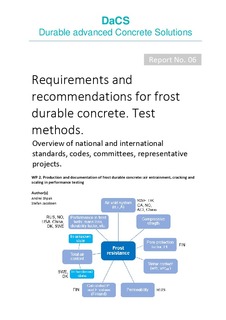| dc.description.abstract | The report gives an overview of requirements and recommendations to frost durable concrete in standards and specifications, available to the author from a limited selection of standardization and engineering organizations in Europe, Russia and North America, and partly China. In order to compare requirements and recommendations from different documents we have decided to divide them into Load, Resistance, Execution, Tests and Acceptance Criteria. Each criteria is organized in detailed tables for the best possible comparison. The results provide an overview for how the frost durability is perceived in standards and regulatory documents in different parts of the world. The results show a great variability in the definition of freeze-thaw resistance Most of the countries limit requirements to the mass-ratio, binder type and content, and the total air content in fresh or hardened concrete. Some set requirements to the air-void system and air content in hardened concrete, while others use requirements based on freeze-thaw tests optionally combined with permeability-related tests and remaining compressive strength. Requirements and recommendations from different international projects show that the industry normally uses the most stringent freeze-thaw test methods (scaling with 3% salt solution, internal cracking with rapid freeze-thaw cycles in water) to meet Clients’ requirements. Yet it is not clear how these types of test methods correlate with real exposure in actual structures. The differences could lie in mismatch between, for example, age of concrete before the test and age of the structure, exposure to salt and water during freeze-thaw cycles of specimen in the test and of real structure, test surface (sawn or formed) and finished surface for actual covering of a roadway, or sidewalk, or formed surface or similar. There is a valuable exposure station project in Sweden, which has provided with a relatively well-correlated data comparison between the European salt-scaling test and frost damage after exposure of samples along salted motorway1. However, based on Canadian experience (Thomas2), the results from North-American salt-frost scaling test and performance of the same concretes at field did not correlate, especially for concrete with high volume of fly ash. In addition to the abovementioned differences between the test and exposed structure, scaling in salt-frost testing has shown to be sensitive to curing, pre-conditioning and ageing before testing. Compared to OPC concrete, carbonation can cause increased scaling for concrete with high content of slag, whilst concrete with fly ash requires longer curing period in order to perform as good as OPC concrete. All in all, most standards are not updated with recent research results, do not account for the steady development of concrete materials (especially towards SCM) and technologies, machinery, construction, and testing techniques. | nb_NO |
